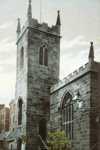 Nottingham Nottingham
St James
History
In 1802 a group of residents living close to the site of St. James proposed the need for a new church and purchased land from the Duke of Newcastle on which to build it. The principal backers were Thomas Hill, Edmund Wright, Richard Eaton and Benjamin Maddock.
One of their reasons for wanting to build a new church was the opinion that the existing Anglican churches were all practicing the high church doctrine, the promoters wanted to follow the evangelical path.
Another issue was the fact that St. Mary's had a waiting list for pews.
The necessary Act of Parliament needed to establish a new church was however blocked by the Archbishop of York at the request of the vicars of the three Anglican churches in the town.
A public meeting was held in 1805 to further the proposal. It was held in the Thurland hall, Nottingham, and chaired by Daniel Parker Coke MP. It was not until 1807 that Parliament passed the required Act, and even then conditions were set. St. James was not allocated land to form a parish, nor was it to be licenced to perform marriages. The foundation stone was laid in 1808 by the newly appointed chaplain, the Rev. J.H. Maddock. Consecration took place in 1809 with Edward Venables Vernon Harcourt, Archbishop of York officiating.
The cost of building the church was £13,000, all of which was raised by the supporters. One method of raising the funds was the auction of the leaseholds of the pews, the best pews being purchased for £40, plus 40 shillings a year rent, considerable sums of money at that time.
In 1851 pews rents raised only £51 annually. Only 140 of the 1540 seats were free, with the parish population only 843 which included 169 soldiers in the barracks to the north of the church space was not an issue.
The Religious Census of 1851 records a congregation of 397 for Sunday the morning service and 460 in the evening. Without a parish, no funding was available from the diocese or church charities leaving the full running costs to be generated by the users. These costs included the cost of the clergy stipend £200 in the first year, plus accommodation and expenses plus a verger.
In 1858 a parish was created mainly encompassing the newly developed former Nottingham Castle deer park generally known as The Park. A vicarage was eventually built in Clare Valley, The Park. Lacking building space most of the activities supported by St. James took place in premises outside the church. In 1898 a day school was operating in Rutland Street, and a Church Institute in Exchange Walk, other activities included, Mothers Meetings, Boys Institute, Temperance Society, Sunday School teachers' class, Bible classes, Elder Girls' Guild and later in the century a company of the Boys' Brigade.
Congregation numbers were declining with the records for Sunday morning communion in the four of September 1904 reaching only 16, 61, 19 and 10. For reasons not recorded but perhaps low usage St. James was united with the parish of St. John the Baptist, Leenside, in 1912. The parishes were not joined geographically being separated by the parishes of both St. Nicholas and St. Peter's. St. John's was located in one of the poorest areas of the town and St. James serviced one of the wealthiest, the former was regarded as ‘high church’ and the later ‘low church’. A contemporary tale has the vicar plainly attired for early Sunday morning communion at St. James and then mounting his bicycle to travel downhill to St. John's to don rich vestments to conduct morning Mass.
Change came again in 1931 when it was proposed that St. James should be released from St. John's and united with St. Peter's. It was not until 1934 that the transfer took place but it was to be short-lived. On 3 March 1935 the last service took place and the church was closed.
A sale had already been agreed with the adjacent Nottingham General Hospital. The building was demolished in 1935 and the hospital authorities erected a new home for their nursing staff known as Pearson House. This building survives following the closure of the hospital in the 1980s, and is now apartments.
Some of the fittings from St. James were transferred to St. James, Porchester, but none remain there today. The funds raised from the sale of the land were also given to St. James, Porchester.
The records of Baptisms 1880-1935 (781) and Marriages 1858-1933, 1933-1935 (500) are held in the Nottinghamshire Archives Office.
| 




